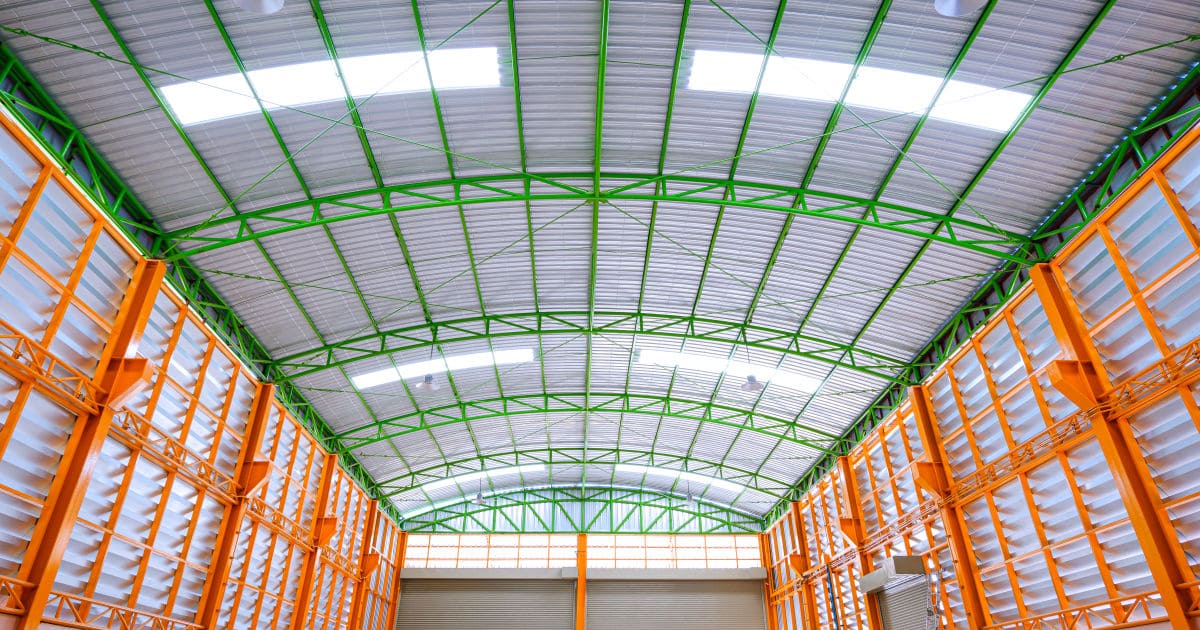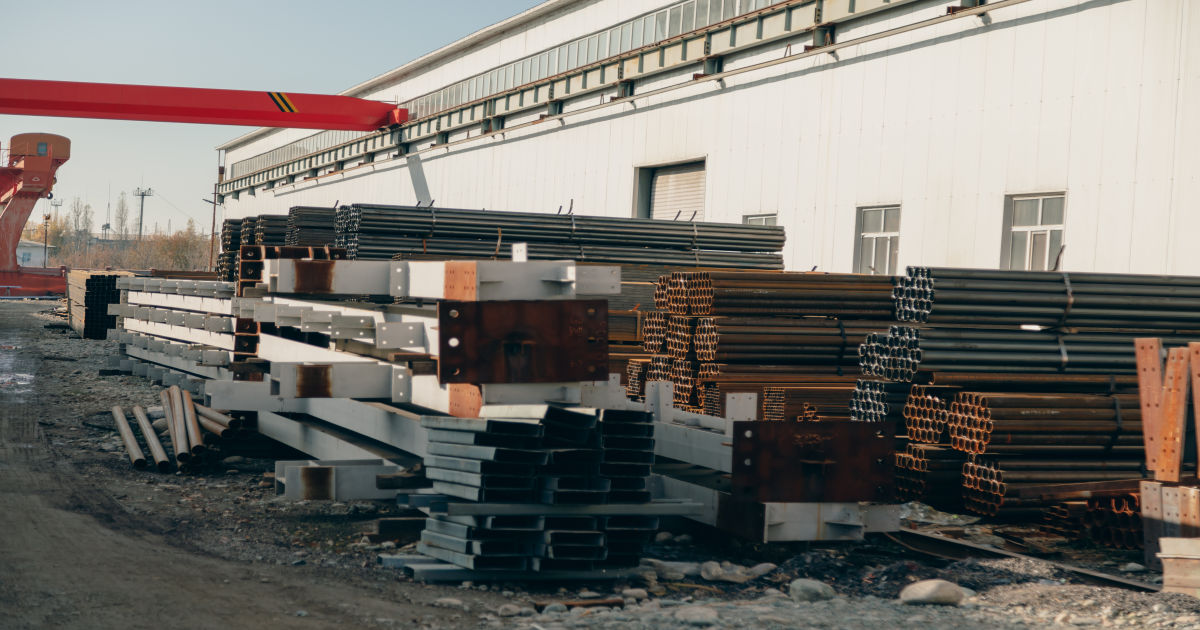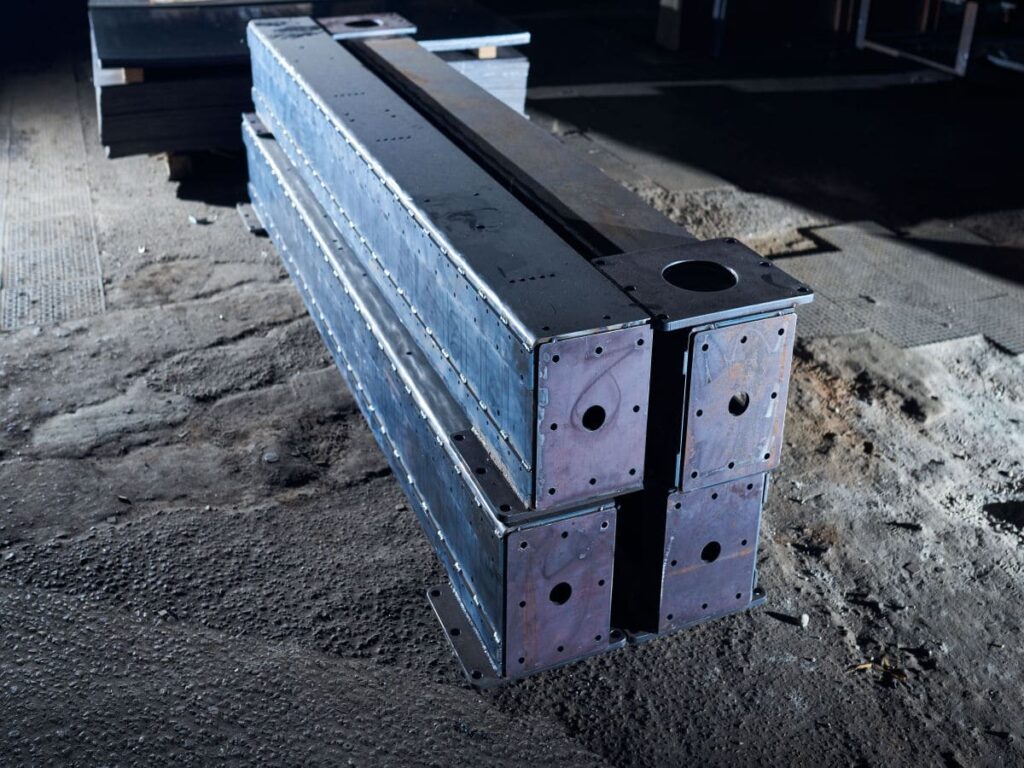Aluminum beams made its entry into the construction industry in the early 20th century. Initially, its high cost limited its use to high-profile structures like the Empire State Building, where it was used primarily for decorative elements and window frames. Over time, advancements in extraction and manufacturing processes made it more affordable, and today, it’s a common material in various types of construction projects.
What Makes Aluminum Suitable for Structural Applications?
Aluminum stands out for its lightweight, corrosion resistance, and high strength-to-weight ratio. It’s about one-third the weight of steel, which allows for easier transportation and installation, reducing labor costs. Its resistance to rust makes it ideal for humid or corrosive environments like coastal areas. The material is also non-magnetic and has good thermal and electrical conductivity, adding to its potential uses in the construction sector.
Properties of Aluminum
Strength-to-Weight Ratio
Importance in Construction
The strength-to-weight ratio of aluminum is a key factor that makes it a popular choice in construction. This metric shows how much load a material can bear relative to its weight. In practical terms, this high ratio allows for the construction of lighter yet sturdy structures, which translates to savings in foundation and material costs and easier and faster installation.
Comparison to Steel
While steel is generally stronger than aluminum, its higher density makes it much heavier. When comparing the strength-to-weight ratio of the two, aluminum often comes out ahead. This advantage makes aluminum particularly useful in applications where weight is a consideration, such as in high-rise buildings and bridges. But, aluminum’s lower tensile strength may not be suitable for all applications requiring extreme load-bearing.

Corrosion Resistance
Chemical Makeup
Aluminum’s corrosion resistance is largely due to its passivation layer. When aluminum comes into contact, it forms a thin aluminum oxide layer. This layer protects metal from oxidation, making it resistant to rust and corrosion. This natural barrier is self-repairing; if scratched or damaged, a new oxide layer will quickly form, offering continuous protection.
Longevity and Maintenance
The corrosion-resistant nature of aluminum lends itself to long-lasting structures with minimal maintenance needs. Unlike steel, which often requires regular painting or galvanization to prevent rust, aluminum structures go years without major upkeep. This results in lower lifetime costs for buildings and infrastructure, making it a cost-effective choice for long-term projects.
Versatility
Range of Alloy Options
One of the standout features of aluminum is its versatility, facilitated by a wide array of alloys. Different alloying elements like magnesium, silicon, or zinc can be added to pure aluminum to enhance specific properties such as strength, flexibility, or thermal conductivity. This allows engineers and architects to choose the most suitable type of aluminum for the particular requirements of their construction project.
Custom Shapes and Designs
Aluminum’s malleability and ease of machining make it ideal for custom shapes and intricate designs. Advanced manufacturing methods like extrusion enable the creation of complex cross-sectional profiles that would be challenging or expensive to achieve with other materials like steel. This flexibility in design opens up many architectural possibilities, making aluminum a go-to material for innovative and aesthetically pleasing structures.
Thermal Conductivity
Insulation Considerations
Aluminum has a high thermal conductivity rate, meaning it easily transfers heat. In construction, this can be both an advantage and a limitation. When used in building envelopes or exterior panels, aluminum’s thermal conductivity may require additional insulation measures to achieve desired energy efficiency levels. For instance, thermal breaks might be used in aluminum window frames to prevent heat transfer and improve insulation.
Applications: Advantages and Disadvantages
The high thermal conductivity is advantageous in applications requiring effective heat dissipation, such as radiator systems or HVAC components. But, this property might be viewed as a drawback in structures that require insulation—like residential homes. It’s important to weigh the thermal conductivity factor in the application context to determine if aluminum is the best material choice for a specific construction scenario.

Using Aluminum Beams
Lighter Weight
Aluminum beams are lighter than their steel counterparts. This reduces labor and equipment costs, speeding up the construction timeline.
Corrosion Resistance
Thanks to its natural oxide layer, aluminum is highly resistant to corrosion. This property makes aluminum beams ideal for use in environments with moisture or corrosive elements, such as coastal or industrial areas.
Lower Overall Cost in Specific Environments
In corrosive or humid settings, the long-term maintenance costs of steel can be high due to rust and corrosion. Aluminum beams, being corrosion-resistant, present a more cost-effective alternative in these specific environments by minimizing maintenance expenses.
Design and Manufacturing Processes
Extrusion
Extrusion is a popular method for producing aluminum beams, where heated aluminum billets are pushed through a die to create specific shapes. This process allows for complex, custom profiles that are uniform across their length, making it ideal for a wide range of construction applications.
Welding
Welding is often employed to combine aluminum pieces, particularly for larger or more complex structures. Aluminum’s lower melting point than steel needs specialized welding techniques, such as TIG (Tungsten Inert Gas) or MIG (Metal Inert Gas) welding, to ensure strong, reliable joints.
Casting
Casting involves putting molten aluminum into molds to create beams or other structural components. Although not as common as extrusion for beams, casting is used for more intricate or specialized parts. The casting process can be less cost-effective for simple beam shapes but is valuable for designs requiring detailed features or complex geometries.
Considerations in Design
Load-Bearing Requirements
The load-bearing requirements are one of the first considerations when designing structures that use aluminum beams. The choice of alloy and the dimensions of the beams must be tailored to withstand both static and dynamic loads. Failure to adequately account for these factors could compromise the structure’s integrity.
Environmental Conditions
The specific environment where the structure will be located also plays a big role in design considerations. For example, choosing an aluminum alloy with high corrosion resistance in coastal or highly humid areas is advisable. Likewise, an alloy with good thermal stability should be selected if the structure is exposed to high temperatures.
Local Construction Codes and Regulations
Local building codes and regulations often have stringent requirements for material quality, fire resistance, and other structural aspects. It’s important to consult these guidelines when designing a structure with aluminum beams to ensure the building is safe and compliant with local standards.

Applications of Aluminum Beams in Construction
Commercial Buildings
Large-span structures are often required to create expansive, unobstructed spaces in commercial settings like warehouses, convention centers, or sports arenas. Aluminum beams come into play here due to their high strength-to-weight ratio. Their lighter weight allows longer spans without needing as many supporting columns, creating more open, flexible spaces. The reduced weight also places less stress on foundations, which can result in cost savings on foundational elements.
Residential Buildings
Aluminum beams are particularly advantageous in constructing modular and pre-fabricated residential buildings. It is easy to transport and assemble, speeding up construction. Aluminum’s corrosion resistance also extends the lifespan of these structures, which is particularly important for modular homes that might be relocated and exposed to different environmental conditions. The ease of machining and customization also allows for versatile designs, a big plus in residential settings where aesthetics are often a key consideration.
Infrastructure Projects
For infrastructure projects like bridges and overpasses, aluminum beams offer several benefits. Their high strength-to-weight ratio allows for longer spans, reducing the need for numerous supports, simplifying design, and lowering construction costs. Aluminum’s corrosion resistance is highly beneficial in environments exposed to elements like water, salt, and changing weather conditions. This translates into less frequent maintenance and longer service life for the structure, making aluminum a practical choice for long-term, durable infrastructure projects.
Sustainability Considerations
Recycling and Reusability
Aluminum is among the most recyclable and reusable construction materials available. Nearly 75% of all aluminum ever produced is still in use today, largely thanks to the ease with which it can be recycled. Unlike many other materials, aluminum can be recycled multiple times without losing quality.
Statistics on Recyclability of Aluminum Beams
According to industry reports, the recycling rate for aluminum construction products is estimated to be around 85%. Recycling aluminum uses 5% of the energy required to produce new aluminum, greatly lowering its environmental impact. These statistics make a compelling case for aluminum’s role in sustainable construction practices.
Environmental impact
Environmental Impact: Energy Efficiency
Aluminum’s inherent properties support energy-efficient designs, although it has some challenges. For instance, its high thermal conductivity allows for effective heat dissipation in specific applications like HVAC systems. But, additional insulating measures may be needed to counter this property in building envelopes or exterior cladding.
Thermal Properties of Aluminum
Aluminum is highly conductive, meaning it easily transfers thermal energy. This property can be advantageous in certain applications but may need thermal breaks in others to maintain energy efficiency.
Contribution to Energy-Efficient Building Designs
Aluminum can still contribute to energy-efficient building designs despite its high thermal conductivity. For instance, aluminum frames with thermal breaks can reduce energy loss in windows. Similarly, reflective aluminum panels can redirect sunlight, reducing cooling costs. In both scenarios, the material aids in creating a more energy-efficient structure when used thoughtfully.
Economic Aspects
Cost Breakdown: Material, Labor, Maintenance
The initial material cost of aluminum can be higher than other construction materials like steel or wood. However, its lighter weight reduces transportation and handling costs, making installing it easier and quicker, which can offset some initial expenses. Over the long term, aluminum’s corrosion resistance minimizes maintenance costs, as it often requires less upkeep than materials susceptible to rust or decay.
Return on Investment Analysis
Analyzing the return on investment (ROI) for using aluminum beams in construction involves several factors. The reduced weight can lead to savings on foundation costs, while the material’s durability can extend the structure’s lifespan, lowering long-term maintenance costs. When aluminum is used correctly, potential energy savings can contribute to lower operational costs. So, despite the initial material expense, the total cost of ownership may be lower, making aluminum a cost-effective choice in many scenarios.
Safety Precautions and Guidelines
Fire Safety Measures
Aluminum has a higher melting point than materials like plastic but is lower than steel. So, fire-resistant coatings or treatments are sometimes applied to meet building codes or increase aluminum structures’ fire resistance. Fire safety is especially important in enclosed spaces or high-occupancy buildings.
Structural Integrity Tests
Before their installation, aluminum beams typically undergo structural integrity tests. These tests evaluate the material’s load-bearing capacity, tensile strength, and resistance to environmental factors like corrosion. Passing these tests is often a requirement to meet local building codes and industry standards.
Recommendations for Safe Handling and Installation
Safe handling of aluminum beams includes using proper lifting equipment and ensuring workers are trained in installation. Given aluminum’s lighter weight, it may seem easier to handle than steel, but appropriate safety measures should still be observed. This includes wearing personal protective equipment and adhering to guidelines for working at heights or confined spaces. Always follow manufacturer recommendations and local regulations to ensure a safe installation process.

Future Trends and Innovations
Research in Aluminum Composites and Nanotechnologies
Aluminum is becoming more important in construction. Researchers are exploring aluminum matrix composites that integrate other materials at the nanoscale. These composites aim to improve aluminum’s strength, corrosion resistance, and thermal properties. As nanotechnologies advance, the potential for lighter, stronger, and more efficient aluminum materials in construction becomes more likely.
Automation in Manufacturing Processes
Automation is becoming a central part of aluminum beam production. Advanced manufacturing techniques, such as robotic extrusion and welding, speed up production and improve the precision and consistency of aluminum components. This can result in higher-quality beams with better structural integrity, opening up new possibilities for complex and demanding architectural designs.
The Alchemy of Aluminum: Shaping Tomorrow’s Skylines
As we look to the future, aluminum beams are poised to play a major role in construction, driven by their unique blend of properties like high strength-to-weight ratio, corrosion resistance, and adaptability. Innovations in material science, such as aluminum composites and nanotechnologies, along with advances in automated manufacturing, are set to make this material even more compelling. Whether in commercial mega-structures, cozy residential settings, or vital infrastructure projects, aluminum is shaping to be a material of the present and the cornerstone of tomorrow’s sustainable, efficient, and awe-inspiring constructions.
Frequently Asked Questions
How Does Aluminum Compare to Steel in Construction?
While steel is generally stronger, aluminum offers a better strength-to-weight ratio, making it ideal for structures requiring lighter materials. Aluminum is also more corrosion-resistant, which can result in lower maintenance costs in certain environments.
Can Aluminum Beams be Recycled?
Aluminum is highly recyclable and can be reprocessed multiple times without losing quality. Nearly 75% of all aluminum produced is used, largely due to its recyclability.
Is Aluminum a Good Choice for Large-Span Structures?
Aluminum is a choice for large-span structures like warehouses or sports arenas, as it allows for longer spans without the need for as many supports.
What are the Safety Things to Consider When Using Aluminum in Construction?
Safety measures include fire-resistant coatings, structural integrity tests, and proper handling and installation protocols. Following these guidelines ensures that the aluminum components meet local building codes and industry standards for safety.
What Innovations are on the Horizon for aluminum in construction?
Research in aluminum composites and nanotechnologies is ongoing, aiming to produce materials with even better properties. Automation in manufacturing processes is also advancing, promising higher precision and efficiency.
Are Aluminum Beams as Strong as Steel?
No, aluminum beams are not as strong as steel in terms of overall tensile and yield strength. However, they offer an excellent strength-to-weight ratio, making them ideal when reducing weight is a priority.
Is 6061 Aluminum Stronger Than Steel?
6061 aluminum is strong for its weight but generally not stronger than structural steel. It’s widely used due to its good balance of strength, corrosion resistance, and machinability, but steel still outperforms it in raw strength.
How Strong Are Aluminium I Beams?
Aluminum I-beams are strong enough for light to moderate structural loads, especially in aerospace, transportation, and non-load-bearing construction. Their strength depends on the alloy, temper, and beam size, but they’re best used where weight reduction matters more than maximum strength.
What Are Aluminum Beams Used For?
Aluminum beams are commonly used in marine structures, trailers, ramps, architectural framing, and lightweight building supports due to their corrosion resistance, low weight, and ease of fabrication.
Further Readings
National Institute of Building Sciences

